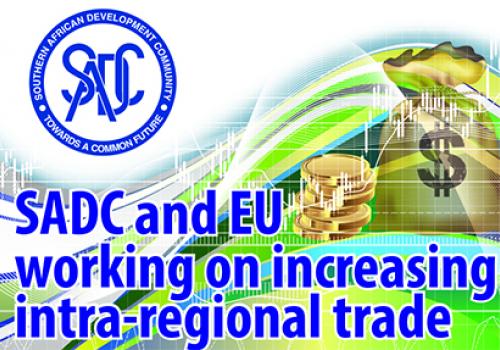The resolution of Non-Tariff-Barriers to trade under the Southern African Development Community (SADC) and the European Union (EU) Trade Facilitation Programme (TFP) is ongoing and playing a key role in the context of the COVID-19 pandemic.
SADC and the EU signed the TFP in 2019 and this is aimed at addressing several elements identified by stakeholders as crucial for developing an improved international market access and for increasing intra-regional trade between SADC Member States.
The programme has to date seen trade flows within the SADC Region and with the outside world increasing along the North-South Corridor. The TFP programme, which will run from 2019 to 2025, is funded to the tune of Euro 15 million by the EU under the 11th Economic Development Fund.
The TFP addresses non-tariff barriers to trade and facilitates harmonisation of technical, sanitary and phytosanitary standards and provides cross-border management tools to speed up processes and reduce the costs of exports within the SADC countries and with the EU. Sanitary and phytosanitary measures set out the basic rules for food safety and animal and plant health standards.
The implementation of EU-SADC Economic Partnership Agreement (EPA) will be facilitated for the six SADC Member States that have signed the agreement and these are Botswana, Eswatini, Lesotho, Mozambique, Namibia, and South Africa.
The TFP was officially launched during the 39th SADC Summit in Dar es Salaam, United Republic of Tanzania, in 2019 and it focuses mainly on regional coordination as well as on capacity building, awareness raising and monitoring. The TFP seeks to increase intra-regional trade flows by supporting trade facilitation.
Speaking at the 40th SADC Summit hosted in virtual format by Mozambique in August, SADC Executive Secretary, Her Excellency Dr Stergomena Lawrence Tax, said the low intra-SADC trade pointed to the urgent need for Member States to improve competitiveness by addressing the supply-side constraints, including strengthening cooperation in cross-border infrastructure, and dealing with non-tariff barriers that remain a hindrance to the smooth flow of goods.
The SADC Secretariat has reviewed the status of industrialisation and market integration in the SADC region over the past year. The review has pointed to the importance of ratifying and implementing the SADC Protocol on Industry, as an important instrument for the promotion of an industrialised and globally competitive regional economy.
Dr Tax said findings by the Secretariat showed that while SADC integration had progressed, there is still work to be done if the region is to effectively promote intra-regional trade, industrialisation, and improve economic growth in the region.
The assessment showed that the structures of SADC economies remain undiversified with a growing dependency on natural resources and export of unprocessed commodities characterised by a stagnant industrial sector.
Natural resource-based sectors, including agriculture and mining, still account for an average 25 percent of Gross Domestic Product (GDP).
Low intra-SADC trade means the region has to do more to address the factors that cause Member States to trade more with the outside world than within the region. Studies have shown that the SADC countries are failing to trade among themselves due to an ineffective manufacturing industry, among other factors.
It was noted that poor infrastructure built during the colonial era hampers the smooth movement of goods, services and people between African countries, as well as the imposition of non-tariff barriers between countries.
The importation process also contributed to the poor economic performance of the region, with high tariffs, differences in laws, regulations and policies hindering intra-regional trade. Studies have also shown that the costs relating to customs in SADC are much higher than those in Asia and other developing countries.
The region has been parting ways with its raw minerals, and buying them back as finished products for a high fee from international markets. Exports from the region remain dominated by unprocessed or minimally processed products, mainly from the agricultural and mineral sectors, resulting in very low value returns.
It was therefore critical for SADC to harmonise policies, laws, regulations and quality standards to increase the volume and value of intra and extra regional trade. Differences in trade and investment policies, laws, regulations and standards were hindering business and economic cooperation between and among SADC Member States, thus affecting the region’s economic performance.
SADC in 2014 adopted the Industrialisation Strategy and Roadmap 2015-2063 in order to increase intra-SADC regional and international trade to help in expanding GDP, create more employment opportunities and reduce poverty in Member States. The region took a decision that industrialisation is a top priority and will feature each year in the theme of the annual SADC Summit.

